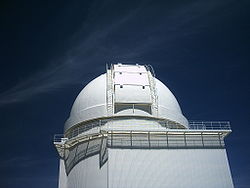Calar Alto Observatory
Observatory in Almería, Spain From Wikipedia, the free encyclopedia
Observatory in Almería, Spain From Wikipedia, the free encyclopedia
The Calar Alto Observatory (Centro Astronómico Hispano en Andalucía or "Spanish Astronomical Centre in Andalusia") is an astronomical observatory located in Almería province in Spain on Calar Alto, a 2,168-meter-high (7,113 ft) mountain in the Sierra de Los Filabres subrange of the Sierra Nevada.[2]
 Enclosure of the 2.2-meter telescope at Calar Alto Observatory | |||||||||||
| Alternative names | Spanish Astronomical Centre in Andalusia | ||||||||||
|---|---|---|---|---|---|---|---|---|---|---|---|
| Organization | Institute of Astrophysics of Andalusia (IAA-CSIC) Council of Andalusia | ||||||||||
| Observatory code | 493 | ||||||||||
| Location | Almería, Spain | ||||||||||
| Coordinates | 37°13′25″N 2°32′46″W | ||||||||||
| Altitude | 2,168 m (7,113 ft) | ||||||||||
| Website | www | ||||||||||
| Telescopes | |||||||||||
| |||||||||||
| | |||||||||||
| see § List of discovered minor planets |
Until 2018, Calar Alto was owned and operated jointly by the German Max Planck Institute for Astronomy in Heidelberg, and the Spanish Institute of Astrophysics of Andalusia (IAA-CSIC) in Granada. It was named the "German–Spanish Astronomical Centre" (in Spanish, Centro Astronómico Hispano-Alemán (CAHA); in German, Deutsch-Spanisches Astronomisches Zentrum). In 2019, the Council of Andalusia takes over the German partner, sharing the observatory with the Spanish National Research Council through its head institute, IAA-CSIC.
Calar Alto telescopes are used for a broad range of observations, from objects in the Solar System[2] to cosmology (the Alhambra and CALIFA surveys), including the search for exoplanets (the CARMENES survey).
The 3.5-meter telescope is the second-largest telescope in mainland Europe after the 4-meter Eastern Anatolian Observatory telescope,[3] though there are three larger telescopes on the Spanish island of La Palma at the Roque de los Muchachos Observatory. The minor planet 189202 Calar Alto, discovered by Felix Hormuth at Starkenburg Observatory in 2003, was named in honor of the observatory site.[2]
The site was proposed in 1970, and was officially opened in July 1975 with the commissioning of its 1.23-meter (48 in) telescope. The site developed thanks to German and Spanish cooperation in astronomy. Eventually, four more telescopes were commissioned. The Schmidt telescope was moved to Calar Alto in 1976 from the Hamburg Observatory at Bergedorf, where it had been completed in 1954. The observatory hosted the finish of Stage 11 of the 2017 Vuelta a España cycling race (the stage was won by Miguel Ángel López), having previously hosted stage finishes in 2004 (won by eventual race champion Roberto Heras) and 2006 (won by Igor Antón). Calar Alto was climbed on Stage 9 of the Vuelta (AUG 2021).
There are 4 main telescopes on site: a 3.5-meter (138-inch), 2.2 m (87 in), and a 1.23 m (48 in) telescope, and an 80 cm (31 in) Schmidt reflector. The 3.5-meter is the largest telescope on European soil with an equatorial mount. There is also a 1.52 m (60 in) telescope that is owned and operated by the Spanish National Observatory and a robotic telescope operated by the Spanish Astrobiology Center (CAB).
The CALIFA survey (Calar Alto Legacy Integral Field Area survey) is an astronomical project to map 600 galaxies with imaging spectroscopy (integral field spectroscopy (IFS)).[4]

The CARMENES survey (Calar Alto high-Resolution search for M-dwarfs with Exoearths with Near-infrared and optical Échelle Spectrographs) is a project to examine approximately 300 M-dwarf stars for signs of exoplanets with the CARMENES instrument on Calar Alto's 3.5m telescope. Operating since 2016, it aims to find Earth-sized exoplanets around 2 ME (Earth masses) using Doppler spectroscopy (also called the radial velocity method).[5][6]
Close to a hundred minor planets have been discovered at Calar Alto by astronomers Luboš Kohoutek, Kurt Birkle, Ulrich Hopp, Johann Baur, Krisztián Sárneczky, Gyula Szabó, Felix Hormuth and Hermann Boehnhardt. In addition, the Minor Planet Center, directly credits "Calar Alto" with the discovery of the following minor planets:[1]
| important; height: 205px; | ||
|---|---|---|
| (63429) 2001 MH5 | 21 June 2001 | list |
| (94223) 2001 BU53 | 17 January 2001 | list |
| (99258) 2001 MF5 | 21 June 2001 | list |
| 124143 Joséluiscorral | 21 June 2001 | list |
| 213269 Angelbarbero | 20 June 2001 | list |
| (247170) 2001 BY10 | 16 January 2001 | list |
| (250482) 2004 DF79 | 18 February 2004 | list |
Seamless Wikipedia browsing. On steroids.
Every time you click a link to Wikipedia, Wiktionary or Wikiquote in your browser's search results, it will show the modern Wikiwand interface.
Wikiwand extension is a five stars, simple, with minimum permission required to keep your browsing private, safe and transparent.